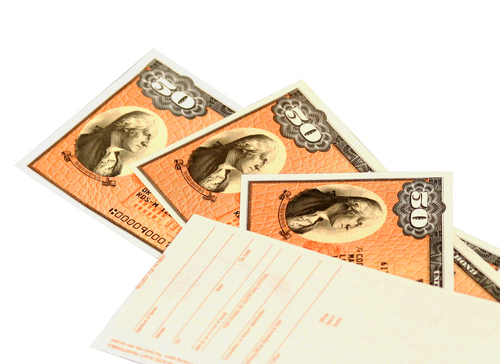Out of the more than $15 trillion the US government owes, just over 1% of that is from savings bonds. Savings bonds are issued by the government, are very safe, and are appealing to those who do not want to take any risk with their portfolio. The tradeoff is that these investments do not come with as high of interest rates seen with many corporately issued bonds. However, not all savings bonds are the same; there are a few different types for the investor to be aware of.
Series EE bonds
Series EE are the most common types of bonds. When an investor purchases new paper EE bonds, they buy them at half of their full value (electronic bonds function differently). Over the next 30 years the value will gradually go up until they mature. At that point the investor will collect the full value of the investment. For instance a bond that was purchased for $25 will mature at $50. Over the lifespan of the bond the holder will collect interest payments every six months. Even though the bonds are set to mature after 30 years, they will often mature sooner. Now there is no reason to hold a bond until maturity, unless it is paying good interest (those bought in the last year or so are most likely paying very low interest). The treasury has made rules that a bond cannot be redeemed within its first year, and if redeemed in the first five years the owner forfeits the last 3 months worth of interest to redeem it early.
Series I bonds
One of the biggest downfalls of a series EE bond is that if inflation skyrockets, the bond will essentially be losing money. In order to compensate, the government also issues series I bonds. The “I” stands for inflation. These bonds are issued much in the same manner as the EE bonds. They are bought at half the mature value, and have a fixed interest rate that is set at the time of purchase. In addition to this fixed rate, series I bonds have an inflation rate. Each May and November the rate adjusts to whatever the rate of inflation is at that time. So the total interest on the bond will be the fixed rate plus the inflation rate. In times of hyperinflation, these bonds will be paying quite a bit. In times of deflation, these bonds will only pay the fixed rate (inflation rider cannot go below zero).
Series HH bonds
Some may remember the series HH bonds, but as of 2004 these bonds are no longer available. The series HH bonds were designed to help provide an income stream to the bond holder. Unlike the EE bond, where the interest is added to the value of the bond increasing its value every year, the HH bond would provide interest in cash. The holder of the bond would buy the bond at full value, and receive an income stream for 20 years, when the HH bond would mature. While the earnings on a series EE bond is not subject to federal taxes, the earnings on an HH bond was/is taxable on a federal level but not state or local taxes.
Savings bonds have their place in certain situations. In today’s low interest rate environment, and with worries about the solvency of the US government, they have become much less popular. Those who have them probably received them as a gift when they were young. The bonds can be left alone to grow, and throughout the years will increase in value and they can be cashed when they are needed for a child’s or grandchild’s education. Everyone’s portfolio is different, and a savings bond is still a good fit for some people. Learn more at www.treasurydirect.gov.






